HI6028 Taxation Assignment: GST and CGT Implications Analysis
VerifiedAdded on 2022/11/09
|9
|1901
|99
Homework Assignment
AI Summary
This assignment analyzes two taxation issues: the claim of input tax credit (ITC) under GST and CGT implications. The first issue assesses whether City Sky Co., a property investment and development company, can claim ITC on legal services related to land acquisition for apartment construction, given their GST registration. The analysis involves the concept of creditable acquisitions and relevant GSTA provisions, calculating the ITC amount. The second issue examines CGT implications for Emma, analyzing transactions including the sale of land, shares, and personal assets like a stamp collection and a grand piano. It involves applying ITAA97 provisions to determine cost bases, cost proceeds, and capital gains/losses, considering elements like acquisition costs, stamp duty, and capital improvements. The conclusion determines the net capital liability, considering discount rates where applicable.
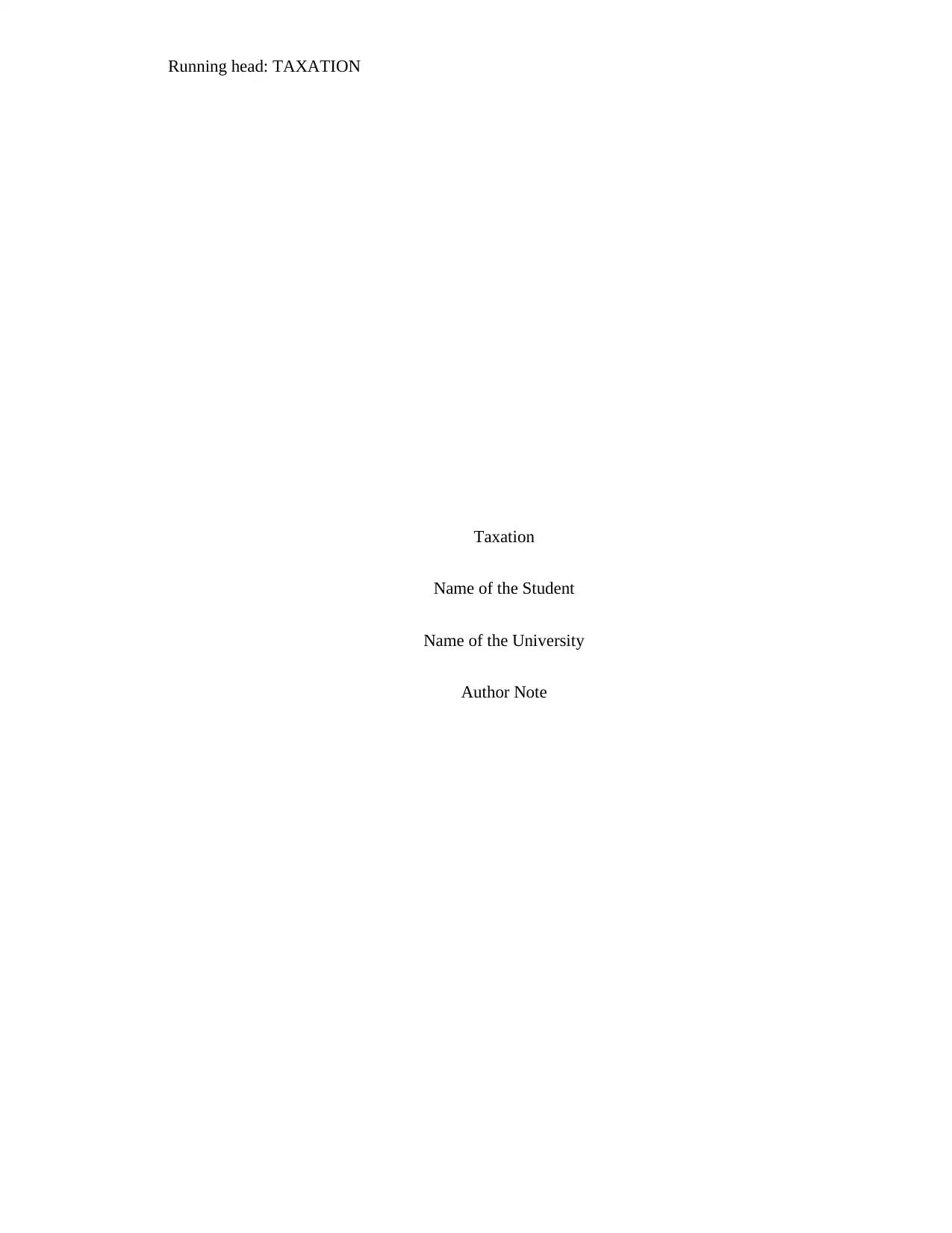
Running head: TAXATION
Taxation
Name of the Student
Name of the University
Author Note
Taxation
Name of the Student
Name of the University
Author Note
Paraphrase This Document
Need a fresh take? Get an instant paraphrase of this document with our AI Paraphraser
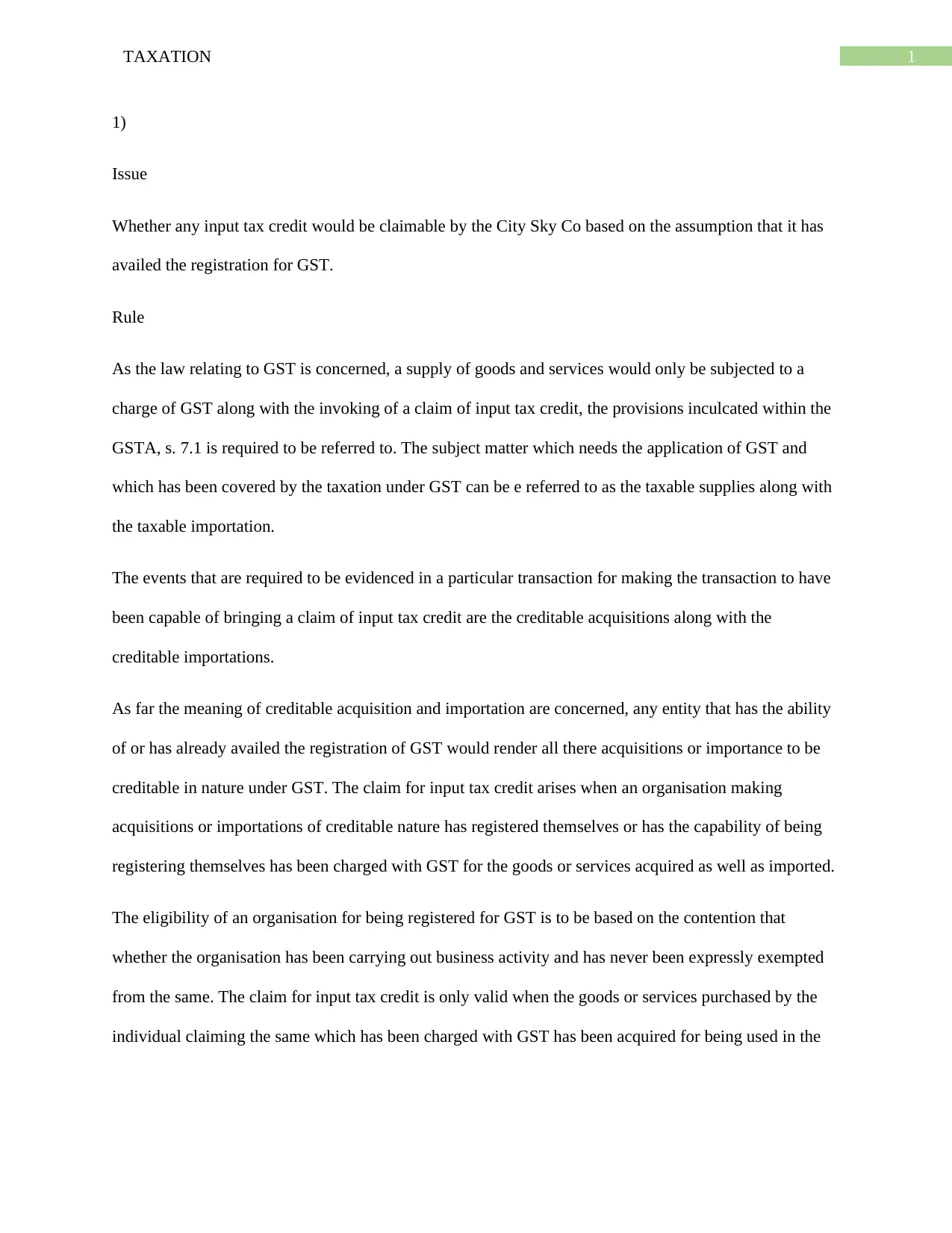
1TAXATION
1)
Issue
Whether any input tax credit would be claimable by the City Sky Co based on the assumption that it has
availed the registration for GST.
Rule
As the law relating to GST is concerned, a supply of goods and services would only be subjected to a
charge of GST along with the invoking of a claim of input tax credit, the provisions inculcated within the
GSTA, s. 7.1 is required to be referred to. The subject matter which needs the application of GST and
which has been covered by the taxation under GST can be e referred to as the taxable supplies along with
the taxable importation.
The events that are required to be evidenced in a particular transaction for making the transaction to have
been capable of bringing a claim of input tax credit are the creditable acquisitions along with the
creditable importations.
As far the meaning of creditable acquisition and importation are concerned, any entity that has the ability
of or has already availed the registration of GST would render all there acquisitions or importance to be
creditable in nature under GST. The claim for input tax credit arises when an organisation making
acquisitions or importations of creditable nature has registered themselves or has the capability of being
registering themselves has been charged with GST for the goods or services acquired as well as imported.
The eligibility of an organisation for being registered for GST is to be based on the contention that
whether the organisation has been carrying out business activity and has never been expressly exempted
from the same. The claim for input tax credit is only valid when the goods or services purchased by the
individual claiming the same which has been charged with GST has been acquired for being used in the
1)
Issue
Whether any input tax credit would be claimable by the City Sky Co based on the assumption that it has
availed the registration for GST.
Rule
As the law relating to GST is concerned, a supply of goods and services would only be subjected to a
charge of GST along with the invoking of a claim of input tax credit, the provisions inculcated within the
GSTA, s. 7.1 is required to be referred to. The subject matter which needs the application of GST and
which has been covered by the taxation under GST can be e referred to as the taxable supplies along with
the taxable importation.
The events that are required to be evidenced in a particular transaction for making the transaction to have
been capable of bringing a claim of input tax credit are the creditable acquisitions along with the
creditable importations.
As far the meaning of creditable acquisition and importation are concerned, any entity that has the ability
of or has already availed the registration of GST would render all there acquisitions or importance to be
creditable in nature under GST. The claim for input tax credit arises when an organisation making
acquisitions or importations of creditable nature has registered themselves or has the capability of being
registering themselves has been charged with GST for the goods or services acquired as well as imported.
The eligibility of an organisation for being registered for GST is to be based on the contention that
whether the organisation has been carrying out business activity and has never been expressly exempted
from the same. The claim for input tax credit is only valid when the goods or services purchased by the
individual claiming the same which has been charged with GST has been acquired for being used in the
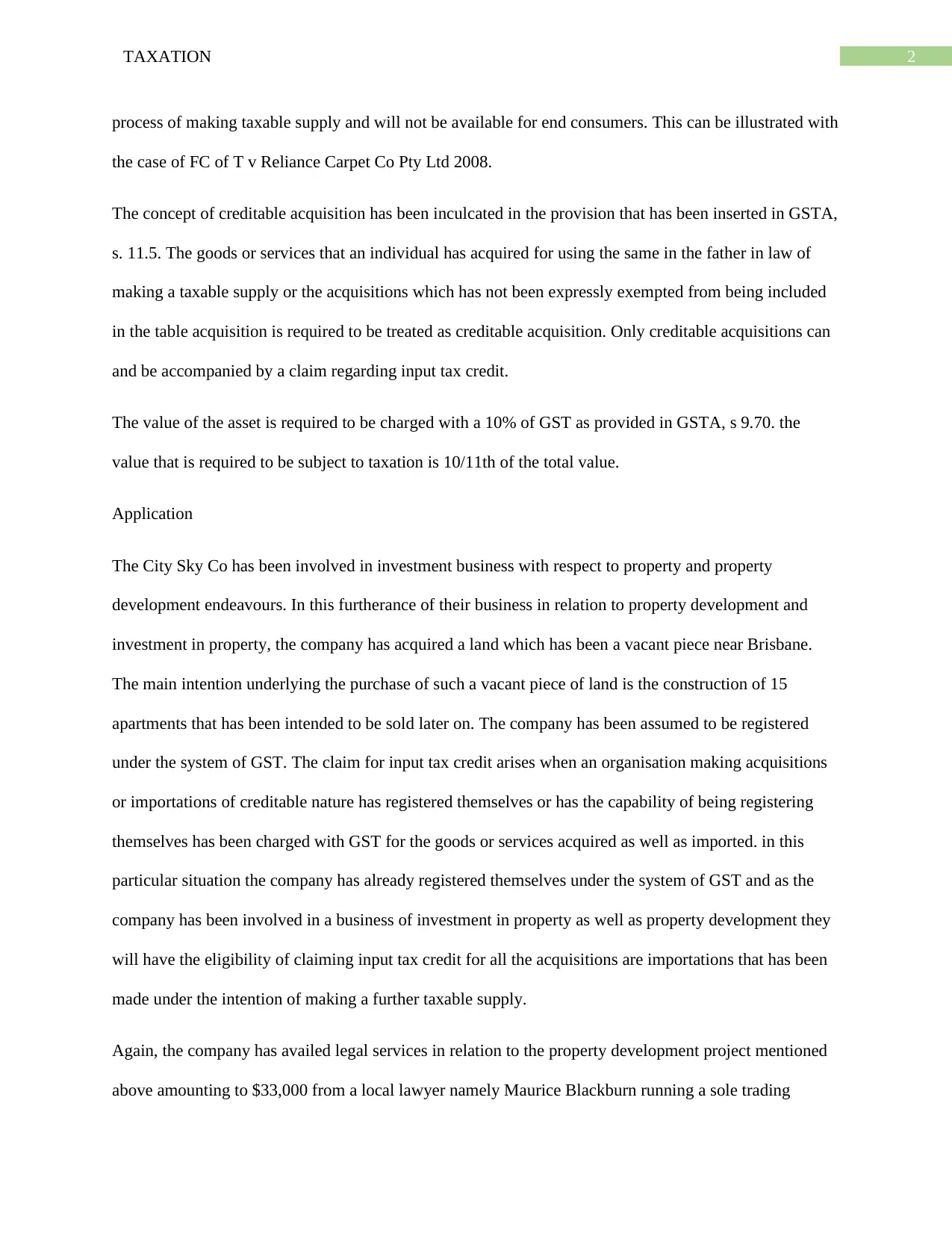
2TAXATION
process of making taxable supply and will not be available for end consumers. This can be illustrated with
the case of FC of T v Reliance Carpet Co Pty Ltd 2008.
The concept of creditable acquisition has been inculcated in the provision that has been inserted in GSTA,
s. 11.5. The goods or services that an individual has acquired for using the same in the father in law of
making a taxable supply or the acquisitions which has not been expressly exempted from being included
in the table acquisition is required to be treated as creditable acquisition. Only creditable acquisitions can
and be accompanied by a claim regarding input tax credit.
The value of the asset is required to be charged with a 10% of GST as provided in GSTA, s 9.70. the
value that is required to be subject to taxation is 10/11th of the total value.
Application
The City Sky Co has been involved in investment business with respect to property and property
development endeavours. In this furtherance of their business in relation to property development and
investment in property, the company has acquired a land which has been a vacant piece near Brisbane.
The main intention underlying the purchase of such a vacant piece of land is the construction of 15
apartments that has been intended to be sold later on. The company has been assumed to be registered
under the system of GST. The claim for input tax credit arises when an organisation making acquisitions
or importations of creditable nature has registered themselves or has the capability of being registering
themselves has been charged with GST for the goods or services acquired as well as imported. in this
particular situation the company has already registered themselves under the system of GST and as the
company has been involved in a business of investment in property as well as property development they
will have the eligibility of claiming input tax credit for all the acquisitions are importations that has been
made under the intention of making a further taxable supply.
Again, the company has availed legal services in relation to the property development project mentioned
above amounting to $33,000 from a local lawyer namely Maurice Blackburn running a sole trading
process of making taxable supply and will not be available for end consumers. This can be illustrated with
the case of FC of T v Reliance Carpet Co Pty Ltd 2008.
The concept of creditable acquisition has been inculcated in the provision that has been inserted in GSTA,
s. 11.5. The goods or services that an individual has acquired for using the same in the father in law of
making a taxable supply or the acquisitions which has not been expressly exempted from being included
in the table acquisition is required to be treated as creditable acquisition. Only creditable acquisitions can
and be accompanied by a claim regarding input tax credit.
The value of the asset is required to be charged with a 10% of GST as provided in GSTA, s 9.70. the
value that is required to be subject to taxation is 10/11th of the total value.
Application
The City Sky Co has been involved in investment business with respect to property and property
development endeavours. In this furtherance of their business in relation to property development and
investment in property, the company has acquired a land which has been a vacant piece near Brisbane.
The main intention underlying the purchase of such a vacant piece of land is the construction of 15
apartments that has been intended to be sold later on. The company has been assumed to be registered
under the system of GST. The claim for input tax credit arises when an organisation making acquisitions
or importations of creditable nature has registered themselves or has the capability of being registering
themselves has been charged with GST for the goods or services acquired as well as imported. in this
particular situation the company has already registered themselves under the system of GST and as the
company has been involved in a business of investment in property as well as property development they
will have the eligibility of claiming input tax credit for all the acquisitions are importations that has been
made under the intention of making a further taxable supply.
Again, the company has availed legal services in relation to the property development project mentioned
above amounting to $33,000 from a local lawyer namely Maurice Blackburn running a sole trading
⊘ This is a preview!⊘
Do you want full access?
Subscribe today to unlock all pages.

Trusted by 1+ million students worldwide
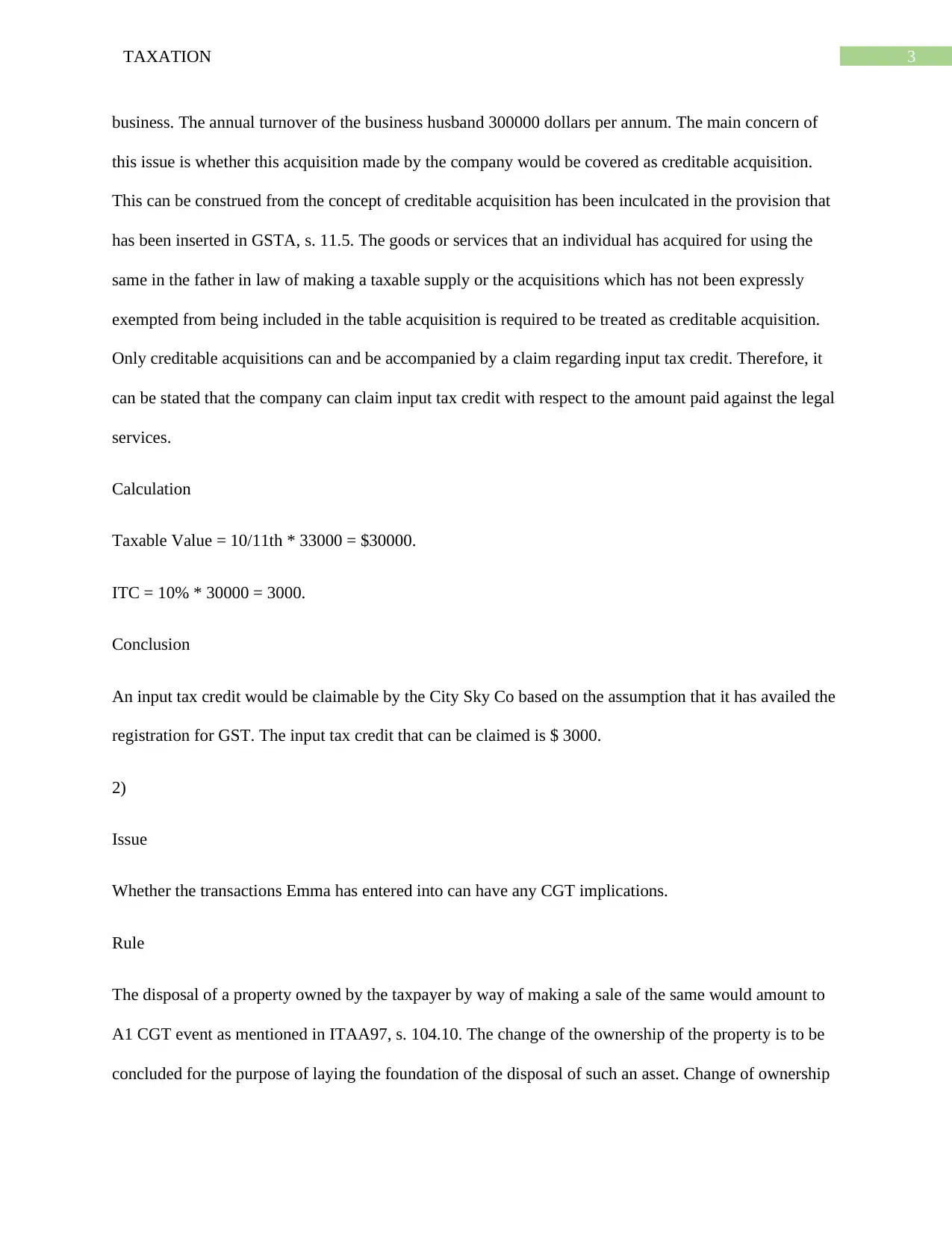
3TAXATION
business. The annual turnover of the business husband 300000 dollars per annum. The main concern of
this issue is whether this acquisition made by the company would be covered as creditable acquisition.
This can be construed from the concept of creditable acquisition has been inculcated in the provision that
has been inserted in GSTA, s. 11.5. The goods or services that an individual has acquired for using the
same in the father in law of making a taxable supply or the acquisitions which has not been expressly
exempted from being included in the table acquisition is required to be treated as creditable acquisition.
Only creditable acquisitions can and be accompanied by a claim regarding input tax credit. Therefore, it
can be stated that the company can claim input tax credit with respect to the amount paid against the legal
services.
Calculation
Taxable Value = 10/11th * 33000 = $30000.
ITC = 10% * 30000 = 3000.
Conclusion
An input tax credit would be claimable by the City Sky Co based on the assumption that it has availed the
registration for GST. The input tax credit that can be claimed is $ 3000.
2)
Issue
Whether the transactions Emma has entered into can have any CGT implications.
Rule
The disposal of a property owned by the taxpayer by way of making a sale of the same would amount to
A1 CGT event as mentioned in ITAA97, s. 104.10. The change of the ownership of the property is to be
concluded for the purpose of laying the foundation of the disposal of such an asset. Change of ownership
business. The annual turnover of the business husband 300000 dollars per annum. The main concern of
this issue is whether this acquisition made by the company would be covered as creditable acquisition.
This can be construed from the concept of creditable acquisition has been inculcated in the provision that
has been inserted in GSTA, s. 11.5. The goods or services that an individual has acquired for using the
same in the father in law of making a taxable supply or the acquisitions which has not been expressly
exempted from being included in the table acquisition is required to be treated as creditable acquisition.
Only creditable acquisitions can and be accompanied by a claim regarding input tax credit. Therefore, it
can be stated that the company can claim input tax credit with respect to the amount paid against the legal
services.
Calculation
Taxable Value = 10/11th * 33000 = $30000.
ITC = 10% * 30000 = 3000.
Conclusion
An input tax credit would be claimable by the City Sky Co based on the assumption that it has availed the
registration for GST. The input tax credit that can be claimed is $ 3000.
2)
Issue
Whether the transactions Emma has entered into can have any CGT implications.
Rule
The disposal of a property owned by the taxpayer by way of making a sale of the same would amount to
A1 CGT event as mentioned in ITAA97, s. 104.10. The change of the ownership of the property is to be
concluded for the purpose of laying the foundation of the disposal of such an asset. Change of ownership
Paraphrase This Document
Need a fresh take? Get an instant paraphrase of this document with our AI Paraphraser
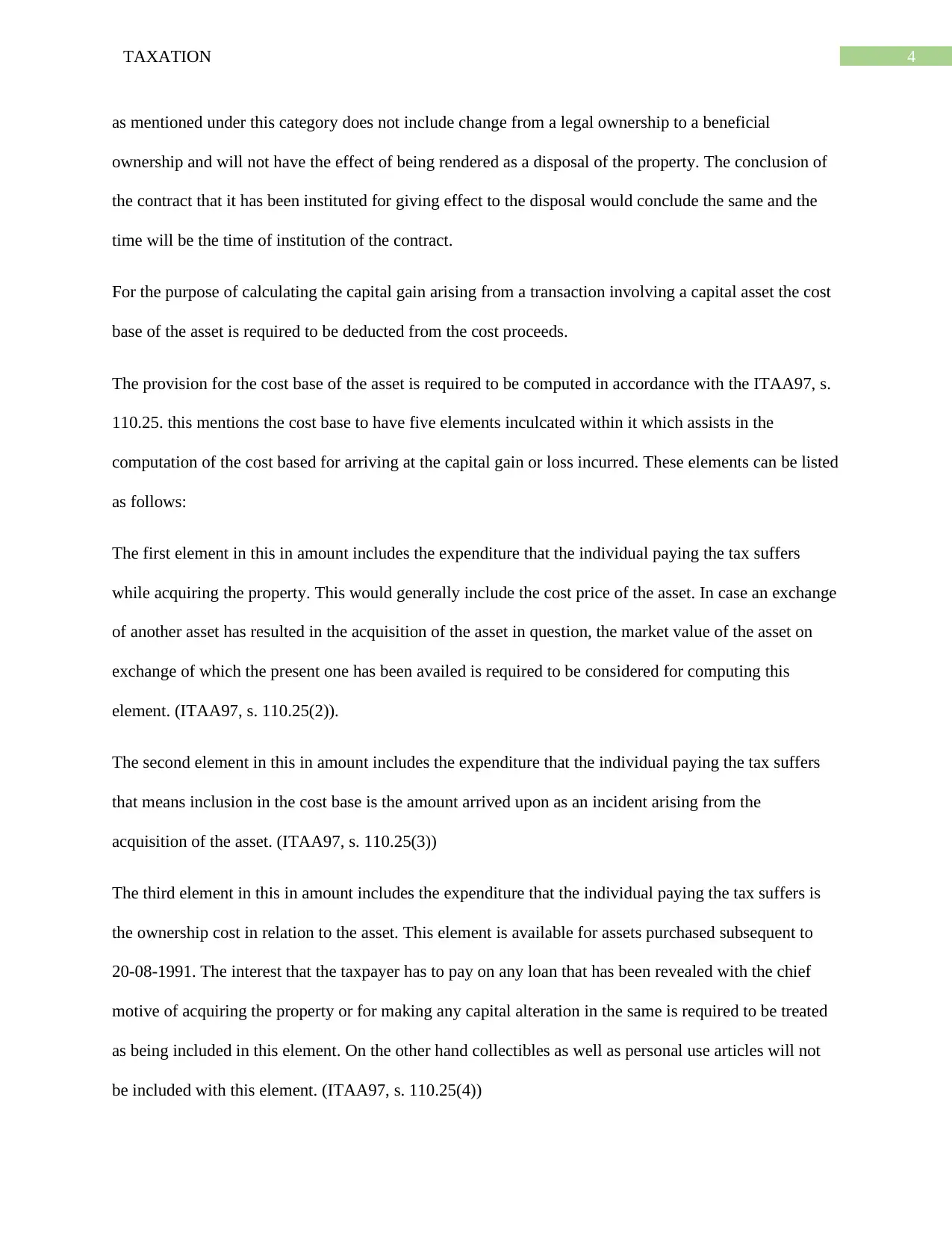
4TAXATION
as mentioned under this category does not include change from a legal ownership to a beneficial
ownership and will not have the effect of being rendered as a disposal of the property. The conclusion of
the contract that it has been instituted for giving effect to the disposal would conclude the same and the
time will be the time of institution of the contract.
For the purpose of calculating the capital gain arising from a transaction involving a capital asset the cost
base of the asset is required to be deducted from the cost proceeds.
The provision for the cost base of the asset is required to be computed in accordance with the ITAA97, s.
110.25. this mentions the cost base to have five elements inculcated within it which assists in the
computation of the cost based for arriving at the capital gain or loss incurred. These elements can be listed
as follows:
The first element in this in amount includes the expenditure that the individual paying the tax suffers
while acquiring the property. This would generally include the cost price of the asset. In case an exchange
of another asset has resulted in the acquisition of the asset in question, the market value of the asset on
exchange of which the present one has been availed is required to be considered for computing this
element. (ITAA97, s. 110.25(2)).
The second element in this in amount includes the expenditure that the individual paying the tax suffers
that means inclusion in the cost base is the amount arrived upon as an incident arising from the
acquisition of the asset. (ITAA97, s. 110.25(3))
The third element in this in amount includes the expenditure that the individual paying the tax suffers is
the ownership cost in relation to the asset. This element is available for assets purchased subsequent to
20-08-1991. The interest that the taxpayer has to pay on any loan that has been revealed with the chief
motive of acquiring the property or for making any capital alteration in the same is required to be treated
as being included in this element. On the other hand collectibles as well as personal use articles will not
be included with this element. (ITAA97, s. 110.25(4))
as mentioned under this category does not include change from a legal ownership to a beneficial
ownership and will not have the effect of being rendered as a disposal of the property. The conclusion of
the contract that it has been instituted for giving effect to the disposal would conclude the same and the
time will be the time of institution of the contract.
For the purpose of calculating the capital gain arising from a transaction involving a capital asset the cost
base of the asset is required to be deducted from the cost proceeds.
The provision for the cost base of the asset is required to be computed in accordance with the ITAA97, s.
110.25. this mentions the cost base to have five elements inculcated within it which assists in the
computation of the cost based for arriving at the capital gain or loss incurred. These elements can be listed
as follows:
The first element in this in amount includes the expenditure that the individual paying the tax suffers
while acquiring the property. This would generally include the cost price of the asset. In case an exchange
of another asset has resulted in the acquisition of the asset in question, the market value of the asset on
exchange of which the present one has been availed is required to be considered for computing this
element. (ITAA97, s. 110.25(2)).
The second element in this in amount includes the expenditure that the individual paying the tax suffers
that means inclusion in the cost base is the amount arrived upon as an incident arising from the
acquisition of the asset. (ITAA97, s. 110.25(3))
The third element in this in amount includes the expenditure that the individual paying the tax suffers is
the ownership cost in relation to the asset. This element is available for assets purchased subsequent to
20-08-1991. The interest that the taxpayer has to pay on any loan that has been revealed with the chief
motive of acquiring the property or for making any capital alteration in the same is required to be treated
as being included in this element. On the other hand collectibles as well as personal use articles will not
be included with this element. (ITAA97, s. 110.25(4))
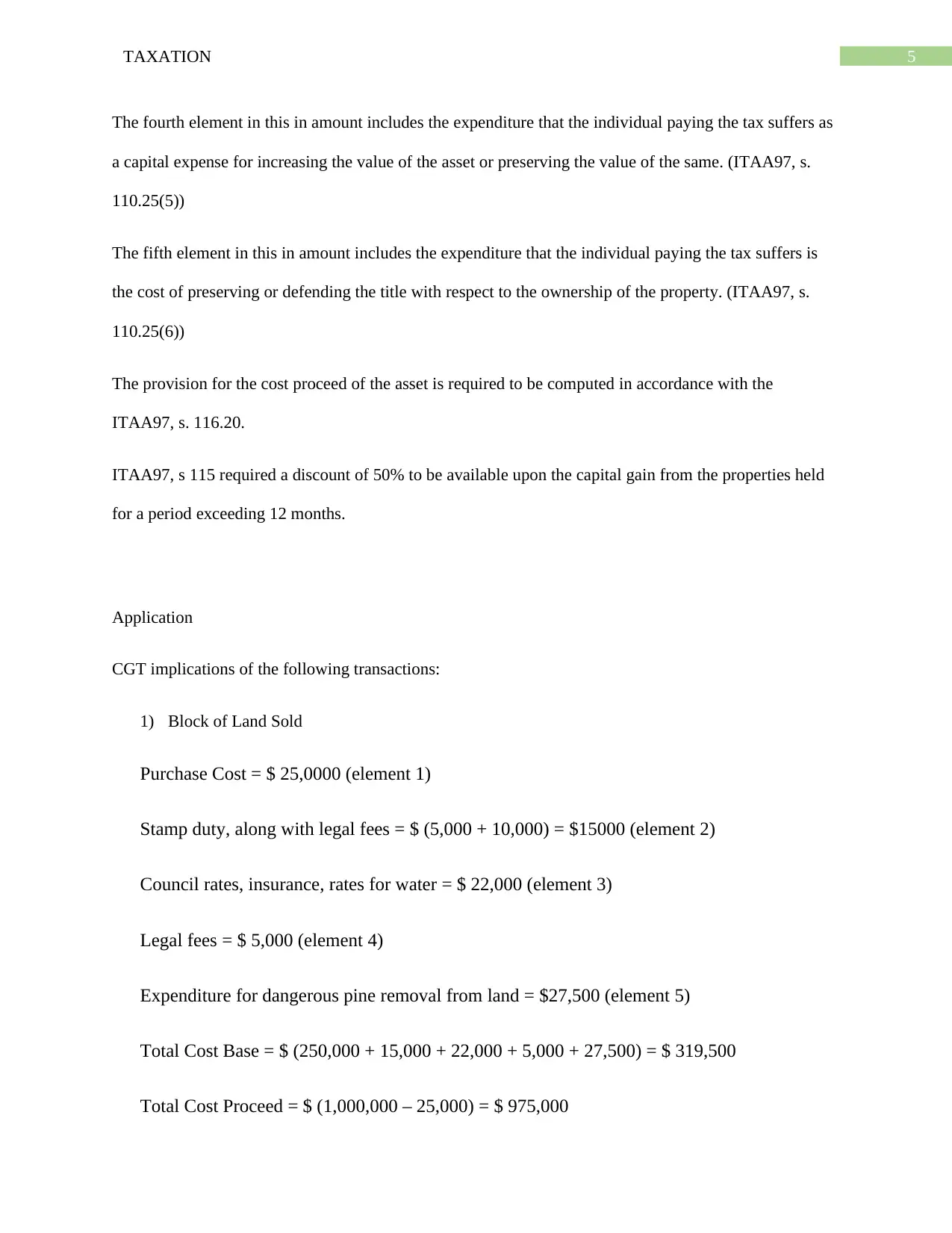
5TAXATION
The fourth element in this in amount includes the expenditure that the individual paying the tax suffers as
a capital expense for increasing the value of the asset or preserving the value of the same. (ITAA97, s.
110.25(5))
The fifth element in this in amount includes the expenditure that the individual paying the tax suffers is
the cost of preserving or defending the title with respect to the ownership of the property. (ITAA97, s.
110.25(6))
The provision for the cost proceed of the asset is required to be computed in accordance with the
ITAA97, s. 116.20.
ITAA97, s 115 required a discount of 50% to be available upon the capital gain from the properties held
for a period exceeding 12 months.
Application
CGT implications of the following transactions:
1) Block of Land Sold
Purchase Cost = $ 25,0000 (element 1)
Stamp duty, along with legal fees = $ (5,000 + 10,000) = $15000 (element 2)
Council rates, insurance, rates for water = $ 22,000 (element 3)
Legal fees = $ 5,000 (element 4)
Expenditure for dangerous pine removal from land = $27,500 (element 5)
Total Cost Base = $ (250,000 + 15,000 + 22,000 + 5,000 + 27,500) = $ 319,500
Total Cost Proceed = $ (1,000,000 – 25,000) = $ 975,000
The fourth element in this in amount includes the expenditure that the individual paying the tax suffers as
a capital expense for increasing the value of the asset or preserving the value of the same. (ITAA97, s.
110.25(5))
The fifth element in this in amount includes the expenditure that the individual paying the tax suffers is
the cost of preserving or defending the title with respect to the ownership of the property. (ITAA97, s.
110.25(6))
The provision for the cost proceed of the asset is required to be computed in accordance with the
ITAA97, s. 116.20.
ITAA97, s 115 required a discount of 50% to be available upon the capital gain from the properties held
for a period exceeding 12 months.
Application
CGT implications of the following transactions:
1) Block of Land Sold
Purchase Cost = $ 25,0000 (element 1)
Stamp duty, along with legal fees = $ (5,000 + 10,000) = $15000 (element 2)
Council rates, insurance, rates for water = $ 22,000 (element 3)
Legal fees = $ 5,000 (element 4)
Expenditure for dangerous pine removal from land = $27,500 (element 5)
Total Cost Base = $ (250,000 + 15,000 + 22,000 + 5,000 + 27,500) = $ 319,500
Total Cost Proceed = $ (1,000,000 – 25,000) = $ 975,000
⊘ This is a preview!⊘
Do you want full access?
Subscribe today to unlock all pages.

Trusted by 1+ million students worldwide
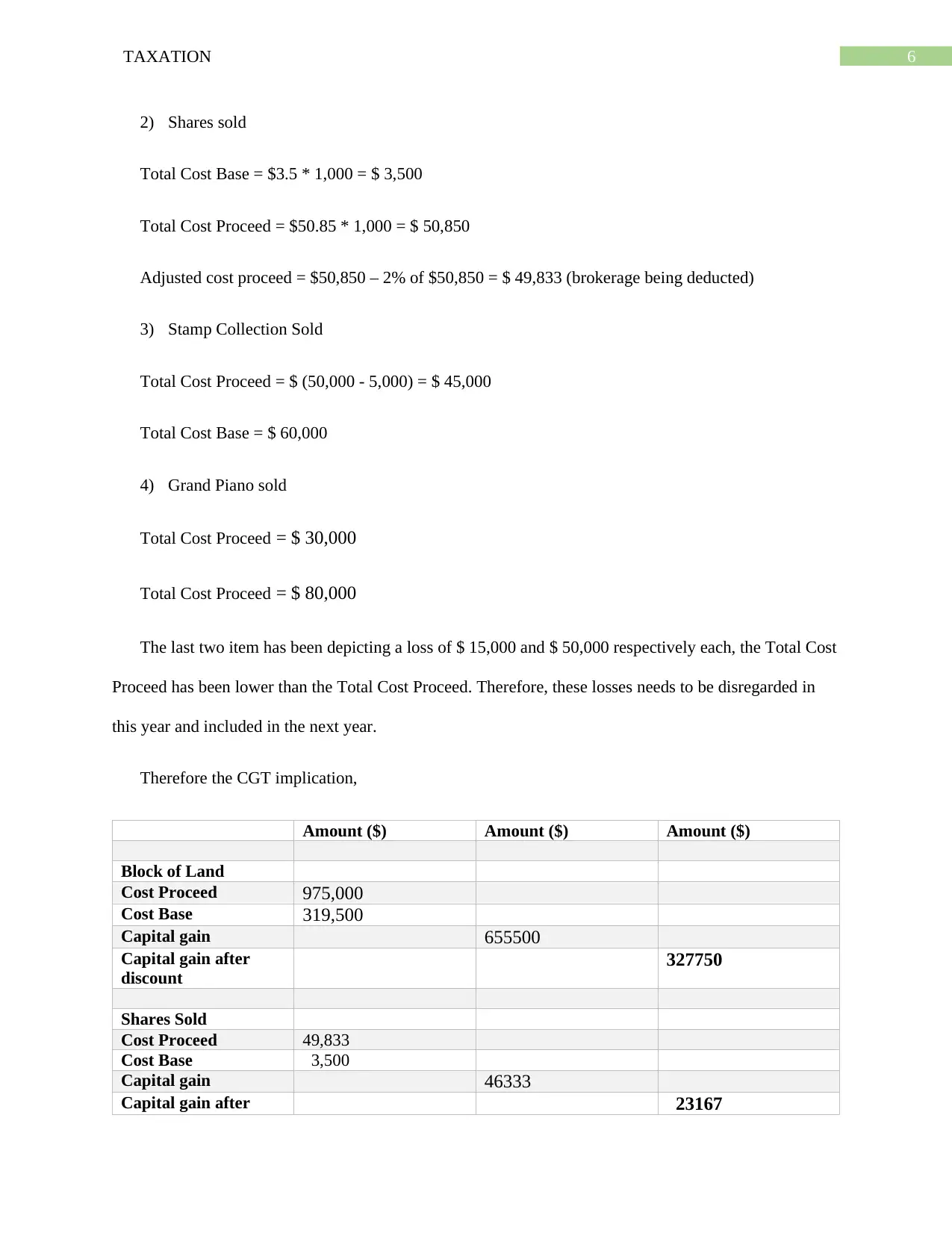
6TAXATION
2) Shares sold
Total Cost Base = $3.5 * 1,000 = $ 3,500
Total Cost Proceed = $50.85 * 1,000 = $ 50,850
Adjusted cost proceed = $50,850 – 2% of $50,850 = $ 49,833 (brokerage being deducted)
3) Stamp Collection Sold
Total Cost Proceed = $ (50,000 - 5,000) = $ 45,000
Total Cost Base = $ 60,000
4) Grand Piano sold
Total Cost Proceed = $ 30,000
Total Cost Proceed = $ 80,000
The last two item has been depicting a loss of $ 15,000 and $ 50,000 respectively each, the Total Cost
Proceed has been lower than the Total Cost Proceed. Therefore, these losses needs to be disregarded in
this year and included in the next year.
Therefore the CGT implication,
Amount ($) Amount ($) Amount ($)
Block of Land
Cost Proceed 975,000
Cost Base 319,500
Capital gain 655500
Capital gain after
discount
327750
Shares Sold
Cost Proceed 49,833
Cost Base 3,500
Capital gain 46333
Capital gain after 23167
2) Shares sold
Total Cost Base = $3.5 * 1,000 = $ 3,500
Total Cost Proceed = $50.85 * 1,000 = $ 50,850
Adjusted cost proceed = $50,850 – 2% of $50,850 = $ 49,833 (brokerage being deducted)
3) Stamp Collection Sold
Total Cost Proceed = $ (50,000 - 5,000) = $ 45,000
Total Cost Base = $ 60,000
4) Grand Piano sold
Total Cost Proceed = $ 30,000
Total Cost Proceed = $ 80,000
The last two item has been depicting a loss of $ 15,000 and $ 50,000 respectively each, the Total Cost
Proceed has been lower than the Total Cost Proceed. Therefore, these losses needs to be disregarded in
this year and included in the next year.
Therefore the CGT implication,
Amount ($) Amount ($) Amount ($)
Block of Land
Cost Proceed 975,000
Cost Base 319,500
Capital gain 655500
Capital gain after
discount
327750
Shares Sold
Cost Proceed 49,833
Cost Base 3,500
Capital gain 46333
Capital gain after 23167
Paraphrase This Document
Need a fresh take? Get an instant paraphrase of this document with our AI Paraphraser
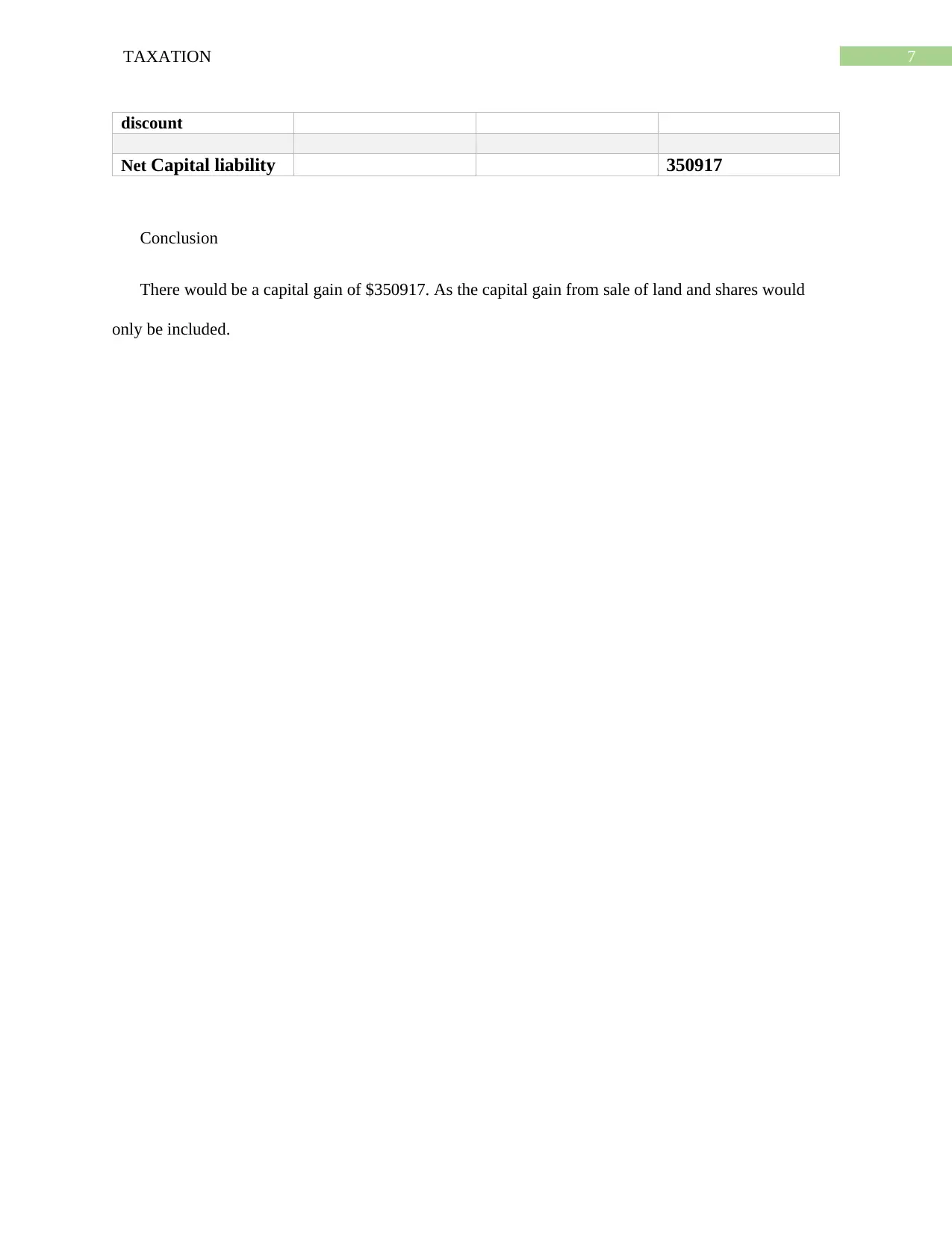
7TAXATION
discount
Net Capital liability 350917
Conclusion
There would be a capital gain of $350917. As the capital gain from sale of land and shares would
only be included.
discount
Net Capital liability 350917
Conclusion
There would be a capital gain of $350917. As the capital gain from sale of land and shares would
only be included.
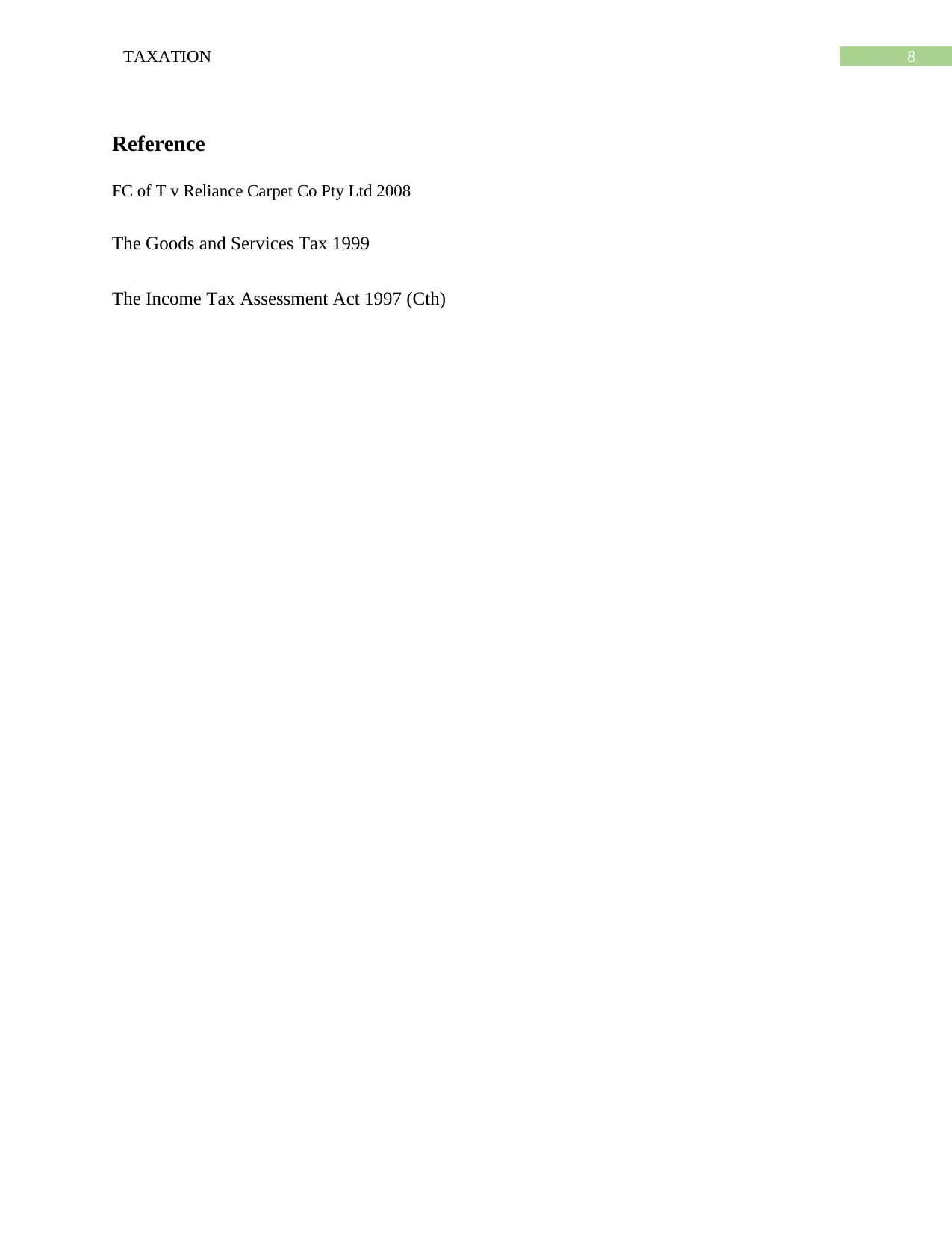
8TAXATION
Reference
FC of T v Reliance Carpet Co Pty Ltd 2008
The Goods and Services Tax 1999
The Income Tax Assessment Act 1997 (Cth)
Reference
FC of T v Reliance Carpet Co Pty Ltd 2008
The Goods and Services Tax 1999
The Income Tax Assessment Act 1997 (Cth)
⊘ This is a preview!⊘
Do you want full access?
Subscribe today to unlock all pages.

Trusted by 1+ million students worldwide
1 out of 9
Related Documents
Your All-in-One AI-Powered Toolkit for Academic Success.
+13062052269
info@desklib.com
Available 24*7 on WhatsApp / Email
![[object Object]](/_next/static/media/star-bottom.7253800d.svg)
Unlock your academic potential
Copyright © 2020–2025 A2Z Services. All Rights Reserved. Developed and managed by ZUCOL.





